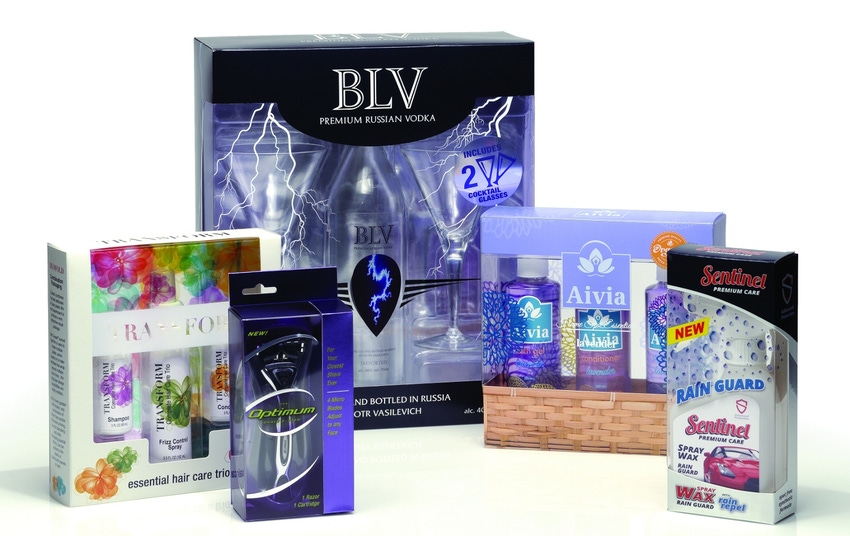
A new dual-material packaging design from HLP Klearfold uses a combination of paperboard and clear, rigid plastic to create a package that is greater than the sum of its parts. Called Duofold, the plastic/paperboard packaging provides an alternative to all-plastic boxes and windowed paperboard cartons.
The combination of materials enables countless structural possibilities and out-of-the-ordinary visual effects that would not be possible with either substrate alone. Discussing Duofold packaging in more detail is Patrick McGee, vp, marketing, at HLP Klearfold.
What benefits does the combination package provide versus conventional windowed cartons?
McGee: The use of rigid, box-grade plastic adds structural integrity to a Duofold package, allowing much larger windowed areas than is possible with traditional paperboard cartons with windows made from a lightweight-plastic patch material. Scoring box-grade plastics using HLP Klearfold’s proprietary Soft Crease RF (radio frequency) technology provides even greater structural integrity and allows creation of Duofold cartons with multiple plastic carton panels or with windows that wrap around multiple score lines.
For even greater shelf impact, any combination of offset, flexo and/or silkscreen printing, plus foil stamping and other decorating special effects, can be applied to either the Duofold’s plastic or paperboard panels, or both. Typically, windowed paperboard cartons cannot have printing on the lightweight, window-patch material.
What plastics are used in Duofold packaging?
McGee: Nearly all of the box-grade plastic that we use for our Klearfold plastic folding carton, as well as for the plastic component of a Duofold carton, is APET (amorphous polyethylene terephthalate). Other PET grades are also available, including rPET, which contains 30% post-consumer recycled content, and bio-PET, up to 30% of which comes from renewable plant-based sources.
What portions of the combination package are recyclable?
McGee: Curbside collection for paperboard is more widely available than it is for printed, rigid plastics. Since the components of a Duofold carton can be easily separated, we recommend that consumers recycle the paperboard component with their other paperboard refuse in curbside collection and also recycle the plastic component, provided their community accepts this type of mixed plastic in its collection program.
What is the run speed of the assembly equipment used to join Duofold components?
McGee: We do not wish to disclose specific run speeds of our new joining equipment, but it is significantly faster than most of the joining equipment used today. Equally important is that our new equipment is far more precise in its operation and its alignment of the multiple, joined components.
Is there any delay for deliveries of Duofold packaging to your customers, compared with your regular all-plastic cartons?
McGee: Although there is one additional process step in the manufacture of Duofold packaging (joining the plastic and paperboard components), lead times are comparable to those of our 100% plastic folding cartons—typically six to eight weeks after approval of artwork.
How much does the combination packaging cost, compared to your all-plastic cartons?
McGee: Unfortunately, we are not able to provide a hard-and-fast rule on the relative cost of a Duofold combination carton as compared to a 100% plastic carton. Since paperboard is a significantly less expensive substrate than box-grade plastic, it makes sense that the raw material cost for a Duofold carton is less.
But there is an additional process step required to join the two carton components. Depending on the complexity and size of the carton design, which dictate the joining run speeds, and the relative size of the paperboard and plastic carton components, Duofold cartons may be more or less expensive than an all-plastic alternative. For customers considering both visual packaging options for a particular project, we will design both carton options for that customer and will provide actual price quotations for both options.
Do you have any commercial customers for Duofold packaging yet?
McGee: Although there are currently many commercial applications for plastic/paperboard combination packaging in the marketplace today, HLP Klearfold is just now installing our high-speed joining equipment, allowing us to add Duofold to our visual-packaging product mix. We have several commercial customer applications currently in development, but we are not able to elaborate until they become commercial.
About the Author(s)
You May Also Like




